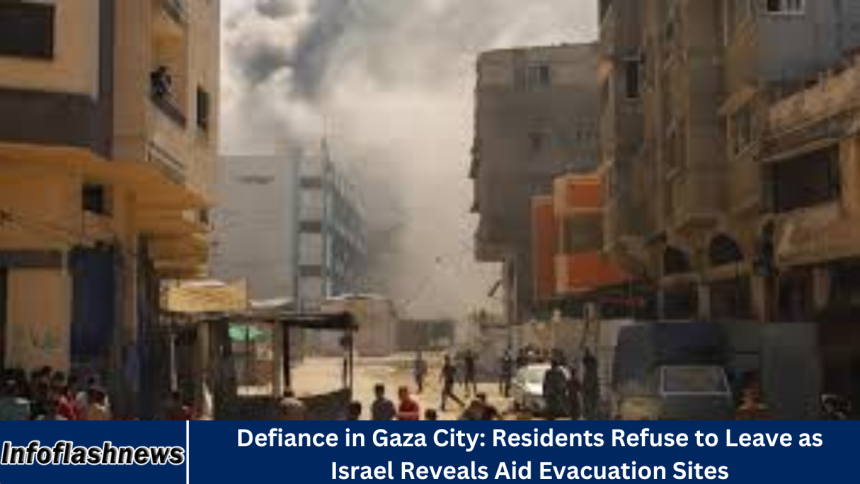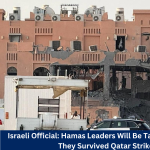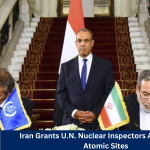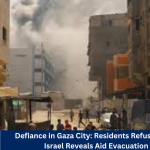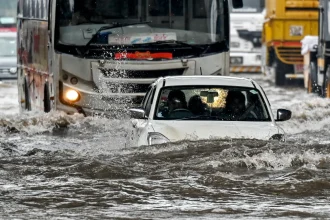As the Israel-Hamas war intensifies, Gaza City has once again become the epicenter of a humanitarian crisis and military confrontation.
With Israeli forces advancing into the northern part of the Gaza Strip and issuing mass evacuation orders, hundreds of thousands of residents remain defiant, refusing to abandon their homes despite the rising threat of airstrikes and ground operations.
This article explores the current situation in Gaza City, the reasons behind residents’ refusal to leave, the state of humanitarian aid and evacuation zones in southern Gaza, and what this means for the broader Israel-Hamas conflict.
More Read: France’s New Prime Minister Faces Nationwide Protests Upon Taking Office
Israel Orders Full Evacuation of Gaza City
On September 10, 2025, the Israeli military issued a sweeping evacuation order to all civilians in Gaza City, urging them to move southward as its forces prepare to take control of what Prime Minister Benjamin Netanyahu has described as the “last significant stronghold of Hamas” in the Gaza Strip.
According to the Israeli Defense Forces (IDF), ground troops now control approximately 40% of Gaza City, and airstrikes continue to demolish infrastructure, including residential towers and public buildings. Despite this, reports from humanitarian groups and international journalists indicate that up to one million people are still residing in the city—many in makeshift shelters or tents amid the rubble.
Netanyahu recently claimed that around 100,000 people have already evacuated, but the majority of civilians remain—many citing lack of resources, fear of further displacement, or a deep-seated attachment to their land.
‘We’re Not Leaving’: Voices from the Ground
The streets of Gaza City echo with a mix of fear, defiance, and desperation. Civilians, many of whom have already been displaced multiple times during the conflict, now face the grim choice of fleeing again or staying in a war zone.
One such voice is Ammar Sukkar, a local resident whose neighborhood was struck by an Israeli airstrike just hours before he spoke to reporters.
“Whether you like it or not, Netanyahu, we’re not leaving,” Sukkar declared. “Go and deal with Hamas, go and kill them. We’re not to blame. Even if we’re buried here, this is my land.”
Others, like Wael Shaban, recount harrowing experiences of 15-minute evacuation warnings before their homes—or in many cases, tents—were destroyed.
“When we came back, the tents, the flour, everything was gone. We don’t have the money to go south,” Shaban said. “Transport costs over 1,500 shekels. We can’t even afford flour to eat.”
These testimonies reveal not only a humanitarian crisis, but also a psychological resistance to Israel’s campaign—residents who see evacuation as surrender, as abandonment of dignity and homeland.
The Israeli Narrative: Security and Safe Zones
From Israel’s perspective, the military operation in Gaza City is a strategic push to dismantle the last urban holdouts of Hamas, which continues to operate underground networks and rocket launch sites across the city.
The IDF has repeatedly stated that it is warning civilians in advance of strikes, using leaflets, phone calls, and text messages to urge evacuation. Israeli officials assert that they are actively working to establish humanitarian corridors and aid distribution points to support displaced civilians in the southern Gaza Strip.
In a recent development, the IDF revealed a new aid distribution site near Rafah, a city near the Egyptian border. The site reportedly includes thousands of newly erected tents, fresh water pipelines from Egypt, and food supplies intended for evacuees.
As part of a highly controlled military embed, BBC journalists were allowed to visit the site—their first access to Gaza since December 2023. While this allowed some limited verification of Israel’s claims, it also highlighted the lack of independent international access to the wider Gaza Strip.
Humanitarian Aid Zones: Overcrowded and Underequipped
While Israel promotes the newly constructed aid zones as safe havens, humanitarian organizations paint a different picture.
The International Committee of the Red Cross (ICRC), along with agencies like Médecins Sans Frontières (MSF) and the United Nations Relief and Works Agency (UNRWA), have warned that the so-called “humanitarian zones” are overwhelmed, under-resourced, and unsafe.
The ICRC has described the mass evacuation plan as “unfeasible” and “incomprehensible,” noting that:
-
Existing shelters are already operating far beyond capacity
-
Medical infrastructure in the south is crippled due to earlier Israeli offensives in cities like Rafah and Khan Younis
-
Food, water, and fuel are critically low, with little access to humanitarian corridors
According to UN estimates, more than 70% of Gaza’s population has been displaced at least once since the conflict reignited in October 2023. Many have no confidence that evacuation leads to safety, citing repeated Israeli airstrikes on so-called safe zones in the past.
Gaza City: Symbol of Resistance or Tactical Error?
Gaza City is not only the administrative and cultural heart of the Gaza Strip; it is also a symbol of Palestinian resistance, making its fate deeply tied to the identity of those who live there.
While Israel views the city as a strategic target, many Palestinians see the order to evacuate as part of a broader campaign of displacement—akin to the Nakba (catastrophe) of 1948, when over 700,000 Palestinians were expelled or fled from their homes during the establishment of the state of Israel.
That historical trauma is never far from the surface in Gaza, where many families live just kilometers from the lands they once owned but cannot return to.
Human rights groups argue that asking an entire population to abandon their city under military threat, especially without guarantees of safety or return, violates international humanitarian law.
Netanyahu’s Military Gamble
Prime Minister Benjamin Netanyahu has staked much of his government’s legitimacy on the total dismantling of Hamas, vowing that “no stone will be left unturned” until the militant group is neutralized.
Yet the long-term cost of this military strategy—both diplomatically and on the ground—remains uncertain. Every tower that falls in Gaza City risks further radicalizing the population. Every civilian death or forced displacement risks international condemnation.
Moreover, with a deepening humanitarian catastrophe, the Israeli government faces growing scrutiny from allies, including the United States and European Union, whose support is conditional upon adherence to international law.
International Reactions and Diplomatic Pressure
So far, the global response to the evacuation orders has been mixed:
-
The United States has continued to back Israel’s right to self-defense but has urged restraint and greater access for humanitarian aid.
-
European nations have condemned attacks on civilians and called for urgent ceasefires to allow for aid delivery.
-
Arab countries, including Egypt and Jordan, have accused Israel of collective punishment and warned of potential regional instability if the war escalates further.
The United Nations has called for an immediate halt to the evacuation order, with Secretary-General António Guterres stating, “There is no safe place in Gaza.”
What Comes Next for Gaza City?
As Israeli tanks edge closer to central Gaza City and airstrikes continue to pound its neighborhoods, the future of the city—and its people—remains dangerously uncertain.
For now, the defiance of residents underscores a broader truth: this is not just a military battle, but also a battle of narratives. Israel sees Gaza City as a necessary target in its war on Hamas. But many Palestinians see it as a final stand for dignity, home, and history.
Whether the evacuation will ultimately be enforced through continued bombardment—or resisted through mass civilian presence—will likely define the next phase of this deeply entrenched conflict.
Frequently Asked Question
Why are Gaza City residents refusing to leave despite evacuation orders?
Many residents say they have nowhere safe to go, lack the financial means for transport, and fear being targeted even in so-called safe zones. Others express a strong emotional and national attachment to their land, refusing to be displaced again.
What has Israel said about the evacuation and aid sites?
Israel claims it is urging civilians to leave Gaza City for their own safety, offering access to newly established aid distribution sites in the south, including tents, food, and water near Rafah.
Are the humanitarian zones in southern Gaza safe and prepared for mass displacement?
No. Aid organizations report that these areas are already overcrowded, with insufficient food, water, medical supplies, and shelter. The International Committee of the Red Cross (ICRC) has called the evacuation plan “incomprehensible.”
How many people are still living in Gaza City?
According to recent estimates, while about 100,000 residents have evacuated, nearly 1 million people remain in Gaza City—many living in makeshift tents or damaged buildings.
What is the military objective of Israel in Gaza City?
Israel views Gaza City as the last major stronghold of Hamas, and aims to take full operational control of the area to dismantle the group’s infrastructure and leadership.
What has been the international response to Israel’s evacuation orders?
Global reactions have been mixed. Some Western nations support Israel’s right to self-defense, while the UN and human rights organizations have condemned the evacuation orders as unworkable and dangerous for civilians.
Is there independent media access to Gaza City right now?
No. Journalists, including the BBC, are only allowed into Gaza through Israeli military embeds, which are tightly controlled and do not permit access to Palestinian-held areas or independent civilian perspectives.
Conclusion
The unfolding crisis in Gaza City highlights the human cost of modern warfare, where strategic objectives collide with humanitarian realities. Despite Israeli assurances of safe zones and aid distribution, the realities on the ground tell a different story—one of overcrowded shelters, collapsing infrastructure, and civilians forced to choose between survival and sovereignty. As Israel prepares for what it calls a “decisive battle” in the north, the world watches a community stand its ground, not just against bombs, but against the erosion of its identity. The defiant cry—“We’re not leaving”—may echo for generations to come.

